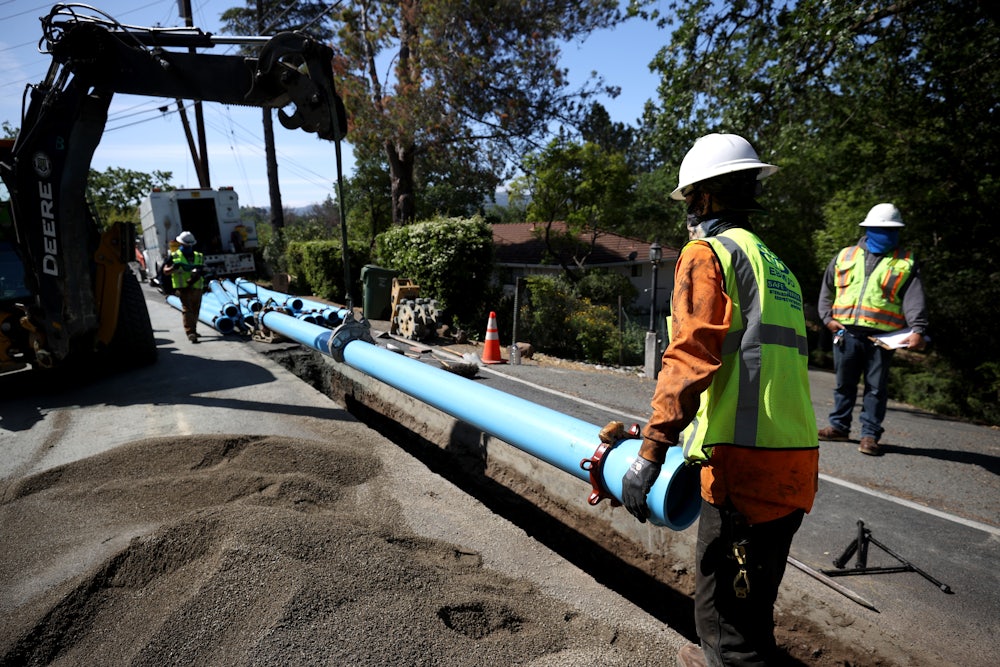Over the last three years, the Biden administration has made a great deal of progress toward replacing the nation’s lead pipes, which are known to cause brain damage to young children. By any measure, getting this job done—which will take at least until 2037, in the best-case scenario—will be a monumental achievement in public health. But replacing those pipes is an expensive proposition, and the amount the federal government has set aside so far, $15 billion (to be distributed over five years), will not be enough to cover it. Complicating matters further, a big chunk of this money—more than $1 billion, according to experts I spoke with—may be allocated to the state of Florida. This is more than almost any other state is set to receive, even though virtually everyone agrees Florida has barely any lead service lines.
It’s unclear who is responsible for the anomaly. The process started when the Environmental Protection Agency sent a survey to states, asking how many lead pipes they needed to replace, and also requesting information about how many pipes were made of “unknown” material—i.e., hadn’t been checked.
The inspector general of the EPA has concluded that two states—the inspector general did not say which ones—sent back incorrect data, though it also faulted the EPA for not verifying the figures. Meanwhile, Florida is blaming the federal government, saying the problem is the EPA’s flawed methodology for calculating states’ needs.
Most of the money, at least in theory, will not go to waste. Experts say that sooner or later, once Florida figures out how many lead pipes it actually needs to replace, any money it doesn’t spend will be reallocated to other states. However, there’s disagreement about how long that might take, and some advocates argue that delays have their own costs. It also raises the specter of a future Congress trying to reappropriate the money (even if this is unlikely, given the bipartisan pressures around lead issues).
“I’m always concerned about losing momentum on this,” said Tom Neltner, national director of the organization Unleaded Kids. At the moment, he said, thousands of water utilities nationwide “are taking this issue very seriously, and they need this money. So to tie it up in Florida—or worse, to waste it doing elaborate inventories that are unnecessary—is wrongheaded.”
To some public health experts, it also bodes badly for the future of the program. They worry that states and utilities that haven’t kept good records are being rewarded with extra funds—which means the money is going disproportionately to agencies that aren’t prepared to spend it effectively.
For centuries, lead was the material of choice for water pipes. The ancient Romans famously used it to channel spring water into their homes. Starting in the Victorian era, it was also favored—and often required—for pipes in the United States, as the country was going through urbanization. But as early as the 1920s, it became clear that even tiny amounts of lead in a person’s bloodstream can be extremely harmful. It’s especially bad for children; it can impair their cognitive development, apparently affecting reading ability and lowering IQ, among other effects.
Even so, lead pipes continued to be installed in public water systems as late as 1986, when the federal government banned them. In 1991, the EPA directed every state to make an inventory of its lead pipes—but virtually none of them did. “That’s why we’re caught where we are now,” said Erik Olson, a senior strategic director for health at the National Resources Defense Council. The NRDC has estimated that there are somewhere between 9.7 and 12.8 million lead pipes still in use throughout the U.S., though it also believes the number could be much higher. The largest share of these are in the Midwest.
The Flint water crisis, which started in 2014, elevated the issue in the public consciousness. Scott Pruitt, the first EPA administrator appointed by Donald Trump, started laying out plans in 2017 for a 10-year program to eradicate lead pipes. The Biden administration has advanced that agenda and made it a top priority; it asked for $45 billion in the Bipartisan Infrastructure Law to help cover the cost, though this was negotiated down to $15 billion.
In deciding how much money to dole out to each state, the EPA depended on data collected in 2021. Florida’s number of lead service lines was estimated at nearly 1.2 million—higher than the figures for Illinois and Pennsylvania, two states with notorious concentrations of lead pipes. Based on those figures, the EPA allocated nearly $255 million for Florida in the first round of funding, compared to $230 million for Illinois and $155 million for Pennsylvania. Most states were allocated less than $30 million.
Neltner was working at the time with the Environmental Defense Fund, or EDF. He and his colleagues there were suspicious. Florida’s population has nearly doubled since 1986, the year when lead pipes were banned from use in construction, and that growth has been accompanied by a massive construction boom. It seemed unlikely that lead pipes would be in wide use, especially in the largest cities: Jacksonville, Miami, Tampa, Orlando, and St. Petersburg.
EDF researchers called the water utility in Pinellas County, where Tampa is located. EPA data showed it had more than 40,000 lead pipes, but the local utility told the EDF it had not supplied this figure. Instead, in a report to the state government, it had labeled all of its service lines “unknown,” because it had never done an inventory.
The EDF then contacted the five other Florida utilities that had exceedingly high numbers. “We heard back from all but one and the sentiment was the same—confusion as to where the numbers in EPA’s dataset came from,” the group said in a report.
In an email to me, the Pinellas County government said its drinking water “consistently exceeds all state and federal standards for consumption,” and affirmed that the EPA data on its lead pipe count is incorrect.
Altogether, according to EPA data, Florida estimated that it had 638,425 lead pipes to replace. It remains unclear how the state arrived at this figure. (It also told the EPA it had another 2.5 million pipes that were of “unknown material” or were “not reported,” and the EPA estimated that 15 percent of these were made of lead—which Neltner thinks is a reasonable guess.)
When I contacted the Florida Department of Environmental Quality, seeking clarification, the agency initially said it was working on a response, but it never supplied one, and the staff stopped responding to my phone calls and emails. Multiple advocates and industry researchers have also said the department has stonewalled them. In early June, however, the department insisted to a regional radio station, WFSU, that the EPA was responsible for any mistakes. The station, paraphrasing the state government, said the EPA’s “methodology” may have been flawed.
A Florida Department of Environmental Protection spokesman told the station, “DEP maintains that once Florida’s drinking water surveys are completed, we expect that the actual extent of facilities with lead service lines documented in Florida will be significantly less than what was estimated by EPA.”
However, if the EPA’s methodology was to blame, it’s hard to say why Florida would have been the only state with grossly inflated numbers. Another possibility is that the state somehow misapplied the EPA’s guidelines.
In the fall of 2023, the EPA gave states a chance to revise their estimates for the second round of funding. Florida apparently made only minor changes, which brought its allocation down from $255 million to slightly less than $229 million—lower than the amount Illinois is receiving, but still far more than almost every other state. If Florida’s figures don’t significantly change, the state will be on track to receive more than $1 billion by the time all the funds are distributed.
Whether or not Florida’s government made any mistakes, a federal watchdog believes the EPA bears the ultimate responsibility. The department’s inspector general issued a memo in May, taking the environmental agency to task. “The EPA, for its part, did not take reasonable measures to verify the state-submitted data to identify anomalies or discrepancies,” the memo reads. Nor did it ask states or utilities to back up their estimates with documentation, showing how they’d collected their data or how they’d crunched the numbers.
The inspector general plans to issue a full report this fall.
In the best-case scenario, Florida will either turn down most of the money it doesn’t need or will return it quickly, once it has a more accurate calculation of its actual needs. The EPA told me it has checks and balances in place to make sure the funding won’t be misused, “including a self-correcting mechanism where funding not used by states will reallotted to states that need it.”
Deirdre Finn, the executive director of the Council of Infrastructure Financing Authorities—which represents state agencies like the Florida DEP on Capitol Hill—explained in an interview how this mechanism works. The EPA won’t actually hand the money over to state governments until they can demonstrate that they need it, she said, and this means submitting a project list.
However, even if this process doesn’t lead to significant delays, Neltner fears that Florida will spend a big chunk of the funds on doing detailed inventories, instead of using more efficient methods to estimate its lead pipe count. “They could be going out and checking every single line for that much,” he said. “It’s hard for a state to walk away from money and not claim it.”
Florida’s project list seems to bear out this concern. An inventory in a large urban area typically costs between $150,000 and $350,000, assuming the estimate is done with predictive modeling, according to the analytics company BlueConduit, which many utilities rely on for guidance. But in a recent draft of its project list for the 2023 fiscal year, the city of Tampa was planning to request $20 million to conduct an inventory and replace any lead pipes it finds, and Pinellas County was requesting $12 million. (The Pinellas County government explained in an email that it’s in the process of replacing all of its analog meters with digital ones, and is checking the pipes as it goes.)
The worst-case scenario is that sometime in the future, the money will be redirected for some other purpose. However, this would take an act of Congress; a president couldn’t do it independently. Finn doubts this will happen. “My sense is that people want to get this job done,” she said. “I just don’t see that there’s much support for that type of change.”
Meanwhile, Ronnie Levin, an instructor at Harvard’s T.H. Chan School of Public Health, has broader concerns. Levin, who was recently featured in Time’s list of the 100 most influential figures in global health thanks to the research and advocacy she’s done on the issue of lead in drinking water, argued that even if the money from the EPA is successfully reallocated, the department’s formula will still penalize states that have been most proactive about replacing their lead pipes, and will reward those that have done the least.
She brought up the case of Michigan. In response to the Flint water crisis, the state has made significant strides toward replacing its lead pipes, starting with a robust inventory. “Michigan now has really good information,” Levin said. But by cutting down on its number of “unknowns,” it may have reduced the amount of money it will get from the EPA—“and that’s not fair.”
On one level, Levin takes heart in knowing that whatever happens, the country will be better off when this program is completed. Even if some of the money ends up being wasted, or spent inefficiently, she said, there will be far fewer lead pipes in the U.S. a decade from now—which will amount to a vast improvement in public health.
At the same time, she cautions against taking too much comfort in this kind of reasoning, because there are high stakes for how the money is used. “If we take $15 billion, put it in a box, and drop it in an ocean, we have made the U.S. a lot worse,” she said. That money could be used for dialysis machines, for instance, or road safety. Even with lead pipes slowly being replaced, Levin said, “we can make big mistakes.”








